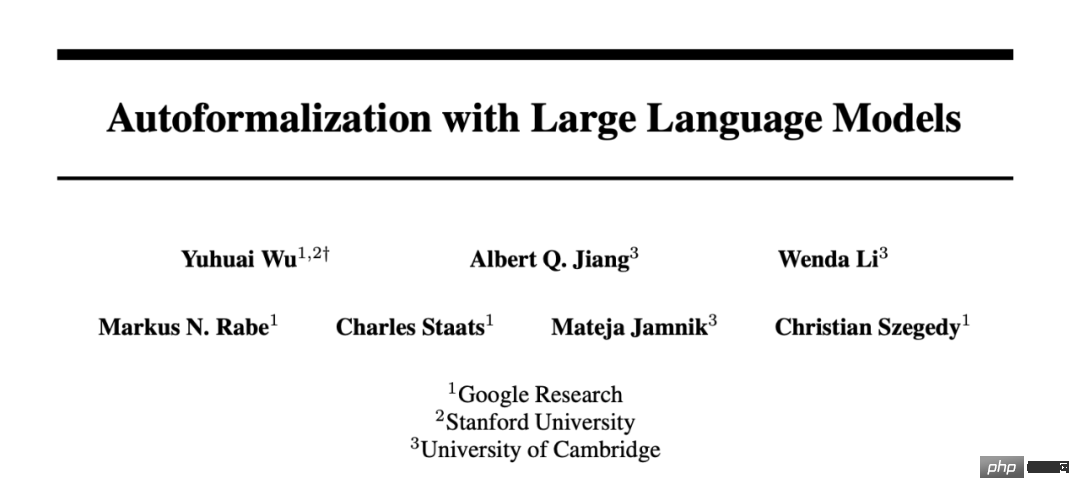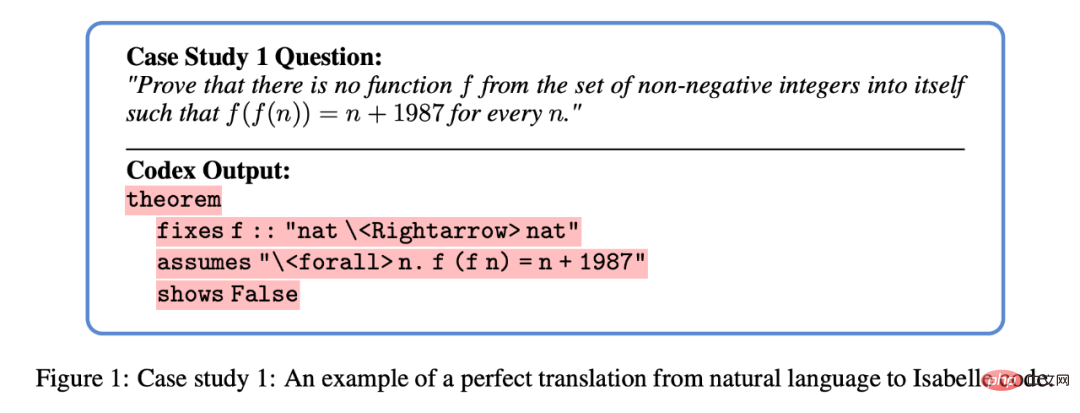 Technology peripherals
Technology peripherals
 AI
AI
 By converting mathematical problems into code, Google's research has greatly improved the accuracy of machine proofs.
By converting mathematical problems into code, Google's research has greatly improved the accuracy of machine proofs.
By converting mathematical problems into code, Google's research has greatly improved the accuracy of machine proofs.
Computers have been used to verify mathematical proofs for some time, but they were only able to do so if the problems were prepared using a specially designed proof language and could not handle the mixture of mathematical notation and written text used by mathematicians .
If you convert mathematical problems written in natural language into formal code and make them easier for computers to solve, it may help build machines that can explore new discoveries in mathematics.
This process is called formalisation, but just one proof can take years of work, so only a small part of mathematical knowledge is formalized and then proven by machines.
Autoformalization refers to the task of automatically translating mathematics from natural language to formal language. The practical and philosophical implications of a successful automated formalization tool would be enormous, it could reduce the current excessive formalization costs, and in the long run, it could connect automated aspects of mathematical reasoning in various research areas.
In a recent study, Google's Yuhuai Wu and his collaboratorsused neural networks from OpenAI Codex to automate formalization work. Codex has been trained on large amounts of text and programming data from the web, and programmers can use it to generate reliable code.

Paper link: https://arxiv.org/pdf/2205.12615.pdf
Formalizing 12,500 middle school mathematics competition problems
A series of recent advances in large-scale language models demonstrate the potential of models to understand formal languages. However, existing successes have been limited to formal languages (such as Python) for which large corpora exist on the web. In contrast, formal mathematical data is very scarce. One of the largest formal mathematical language libraries, Archive of Formal Proofs, is only 180mb in size, which is less than 0.18% of the training data of the large language model Codex.
Furthermore, unlike the case for general-purpose programming languages, where natural language docstrings are widely available, there is little alignment of data between natural languages and formal mathematical languages. Therefore, it is still unknown whether the success of large-scale language models can directly promote the development of automatic formalization.
Given the similarities between proof languages and programming languages, the team decided to see if Codex could formalize a library of 12,500 middle school math competition problems. It is able to convert a quarter of the problems into a format compatible with the formal proof solver Isabelle.
Wu said many unsuccessful conversions are the result of the system not understanding certain mathematical concepts. "If you show the model with an example that explains the concept, then the model can quickly grasp it."
This work explores the prospects of automatic formalization of large language models. The researchers found that large language models Already have a pretty good ability to formalize natural language mathematics in an interactive theorem prover.
Figure 1 below is a perfect example of automatic formalization. Not only does the model convert syntactically correct Isabelle code, it is also able to capture important reasoning points in natural language.

To test the effectiveness of this automated formalization process, the team then applied Codex to a set of problems that already had human formalized versions, for which the Codex was also generated Developed its own formalized version. The team used another AI called MiniF2F to solve both versions of the problem.
Automatically formalizing the problem increases MiniF2F’s success rate from 29% to 35%, indicating that Codex has made important progress in problem formalization.

It is worth noting that presentations in many mathematics competitions tend to be of the form: one is asked to find the answer to a certain problem, rather than to prove a given proposition. However, formal mathematical statements are in the form of propositions, not questions.
In order to convert a question into a proposition, the researcher attached "The Final Answer" after the question:

is used for automatic formalization The prompt format is:

Will AI compete with human mathematicians?
It's an interesting development, but Wu says the team's work is just a proof of concept. "If the goal is to train a machine that is comparable to the top human mathematicians, then automatic formalization seems to be the key path to achieve this goal."
Albert Jiang, a member of the Cambridge University team, said that if the success rate is further improved, AI will be able to compete with human mathematicians. "If we reach 100%, we will definitely create an AI agent that wins the International Mathematical Olympiad gold medal."
The team's immediate goal is to improve automatic formal models and automation Proof of the machine, but the future impact of the research findings will be far more profound. Wu says these models can reveal areas of mathematics currently unknown to humans.
The reasoning capabilities of this machine are also very suitable for verification tasks in a wider range of fields. "You can verify that a piece of software does exactly what you want it to do, or you can verify a hardware chip, so it has applications in financial trading algorithms and hardware design."
Using machines to explore mathematics is an exciting Excited about the development, says Yang-Hui He of the Institute of Mathematical Sciences in London, but the real challenge is using the model in mathematical research that is mostly written in LaTex. "We only use LaTex because it is smooth to type, but it is a natural language in a sense and has its own rules."
He said, because users can define their own functions and Notations, these functions and symbols may only be used in one mathematics paper, which can be tricky for neural networks trained only on plain text.
The above is the detailed content of By converting mathematical problems into code, Google's research has greatly improved the accuracy of machine proofs.. For more information, please follow other related articles on the PHP Chinese website!

Hot AI Tools

Undresser.AI Undress
AI-powered app for creating realistic nude photos

AI Clothes Remover
Online AI tool for removing clothes from photos.

Undress AI Tool
Undress images for free

Clothoff.io
AI clothes remover

AI Hentai Generator
Generate AI Hentai for free.

Hot Article

Hot Tools

Notepad++7.3.1
Easy-to-use and free code editor

SublimeText3 Chinese version
Chinese version, very easy to use

Zend Studio 13.0.1
Powerful PHP integrated development environment

Dreamweaver CS6
Visual web development tools

SublimeText3 Mac version
God-level code editing software (SublimeText3)

Hot Topics
 1378
1378
 52
52
 How to implement file sorting by debian readdir
Apr 13, 2025 am 09:06 AM
How to implement file sorting by debian readdir
Apr 13, 2025 am 09:06 AM
In Debian systems, the readdir function is used to read directory contents, but the order in which it returns is not predefined. To sort files in a directory, you need to read all files first, and then sort them using the qsort function. The following code demonstrates how to sort directory files using readdir and qsort in Debian system: #include#include#include#include#include//Custom comparison function, used for qsortintcompare(constvoid*a,constvoid*b){returnstrcmp(*(
 How to optimize the performance of debian readdir
Apr 13, 2025 am 08:48 AM
How to optimize the performance of debian readdir
Apr 13, 2025 am 08:48 AM
In Debian systems, readdir system calls are used to read directory contents. If its performance is not good, try the following optimization strategy: Simplify the number of directory files: Split large directories into multiple small directories as much as possible, reducing the number of items processed per readdir call. Enable directory content caching: build a cache mechanism, update the cache regularly or when directory content changes, and reduce frequent calls to readdir. Memory caches (such as Memcached or Redis) or local caches (such as files or databases) can be considered. Adopt efficient data structure: If you implement directory traversal by yourself, select more efficient data structures (such as hash tables instead of linear search) to store and access directory information
 How to set the Debian Apache log level
Apr 13, 2025 am 08:33 AM
How to set the Debian Apache log level
Apr 13, 2025 am 08:33 AM
This article describes how to adjust the logging level of the ApacheWeb server in the Debian system. By modifying the configuration file, you can control the verbose level of log information recorded by Apache. Method 1: Modify the main configuration file to locate the configuration file: The configuration file of Apache2.x is usually located in the /etc/apache2/ directory. The file name may be apache2.conf or httpd.conf, depending on your installation method. Edit configuration file: Open configuration file with root permissions using a text editor (such as nano): sudonano/etc/apache2/apache2.conf
 How debian readdir integrates with other tools
Apr 13, 2025 am 09:42 AM
How debian readdir integrates with other tools
Apr 13, 2025 am 09:42 AM
The readdir function in the Debian system is a system call used to read directory contents and is often used in C programming. This article will explain how to integrate readdir with other tools to enhance its functionality. Method 1: Combining C language program and pipeline First, write a C program to call the readdir function and output the result: #include#include#include#includeintmain(intargc,char*argv[]){DIR*dir;structdirent*entry;if(argc!=2){
 How Debian OpenSSL prevents man-in-the-middle attacks
Apr 13, 2025 am 10:30 AM
How Debian OpenSSL prevents man-in-the-middle attacks
Apr 13, 2025 am 10:30 AM
In Debian systems, OpenSSL is an important library for encryption, decryption and certificate management. To prevent a man-in-the-middle attack (MITM), the following measures can be taken: Use HTTPS: Ensure that all network requests use the HTTPS protocol instead of HTTP. HTTPS uses TLS (Transport Layer Security Protocol) to encrypt communication data to ensure that the data is not stolen or tampered during transmission. Verify server certificate: Manually verify the server certificate on the client to ensure it is trustworthy. The server can be manually verified through the delegate method of URLSession
 Debian mail server firewall configuration tips
Apr 13, 2025 am 11:42 AM
Debian mail server firewall configuration tips
Apr 13, 2025 am 11:42 AM
Configuring a Debian mail server's firewall is an important step in ensuring server security. The following are several commonly used firewall configuration methods, including the use of iptables and firewalld. Use iptables to configure firewall to install iptables (if not already installed): sudoapt-getupdatesudoapt-getinstalliptablesView current iptables rules: sudoiptables-L configuration
 How to learn Debian syslog
Apr 13, 2025 am 11:51 AM
How to learn Debian syslog
Apr 13, 2025 am 11:51 AM
This guide will guide you to learn how to use Syslog in Debian systems. Syslog is a key service in Linux systems for logging system and application log messages. It helps administrators monitor and analyze system activity to quickly identify and resolve problems. 1. Basic knowledge of Syslog The core functions of Syslog include: centrally collecting and managing log messages; supporting multiple log output formats and target locations (such as files or networks); providing real-time log viewing and filtering functions. 2. Install and configure Syslog (using Rsyslog) The Debian system uses Rsyslog by default. You can install it with the following command: sudoaptupdatesud
 Debian mail server SSL certificate installation method
Apr 13, 2025 am 11:39 AM
Debian mail server SSL certificate installation method
Apr 13, 2025 am 11:39 AM
The steps to install an SSL certificate on the Debian mail server are as follows: 1. Install the OpenSSL toolkit First, make sure that the OpenSSL toolkit is already installed on your system. If not installed, you can use the following command to install: sudoapt-getupdatesudoapt-getinstallopenssl2. Generate private key and certificate request Next, use OpenSSL to generate a 2048-bit RSA private key and a certificate request (CSR): openss



